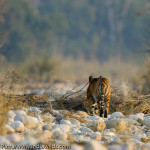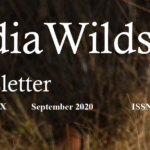IndiaWilds Newsletter Vol. 7 Issue III
Highway to Oblivion:
Highways have integrated various regions and have helped in economic development. Till date Sher Shah Suri is remembered for constructing the Sadak-e-Azam which later became the Grand Trunk Road. Much later in Modern India, when the then Prime Minister Shri Atal Bihari Vajpayee announced his plan for the Golden Quadrilateral and East-West-North-South road building projects, there was much derision. However, within a few years time the benefit of the road building became apparent. Unfortunately, no one had visualised that these roads will be the cause of destruction of Wild India.
Just like a tool designed to enhance productivity can also cause destruction due to improper use, our ill-planned highways have become the cause of not only killing wildlife but also fragmenting their habitat. There have been many scientific studies which have given clear proof of habitat fragmentation leading to reduced genetic diversity and resulting in loss of ability of a specis to cope up with the changing environment and facing extinction in the long term.
Our economic planners and Government officials very well understand the meaning of contiguity. Sometime back a SEZ (Special Economic Zone) project of a well known corporate was rejected as it was divided by a linear infrastructure. The Commerce Ministry didn’t allow a bridge over it to classify the areas as contiguous.
So when a National Highway passes through prime tiger habitat obviously it would be understood by the Government that the habitat is fragmented and no longer contiguous. However the Government, including MoEF&CC – the arm which should be the guardian of Wild India seems to be oblivious to the impact of roads on our wildlife. In a meeting to discuss widening of NH-7, even overpass and underpass suggested by experts to connect both the sides – so as to help wildlife pass to the other side – was not only junked by NHAI but the Hon’ble Minister for MoEF&CC called it impractical and un-executable, clearly showing scant regard for our wildlife and our precious bio-diversity.
The NH-7 (National Highway 7) passing through the Kanha-Pench landscape through Madhya Pradesh and Maharashtra is being widened to make it four lane so that high speed and container traffic can carry goods to our Industrial and commercial areas faster. Wildlife conservationists were alarmed when the Wildlife Institute of India had given the green signal to this fragmentation of habitat by this four-laning of NH-7 passing through the Kanha-Pench landscape, albeit by suggesting some mitigation measures in form of overpass and under passes along the way. Unfortunately, not only this project is championed by the Highways and Transport minister Mr. Gadkari, the entire BJP Government seems to be behind it and the Minister for MoEF Mr. Javadekar, instead of thinking about the welfare of wildlife has termed the mitigation measures suggested by WII as impractical and un-executable.
In 2009, the Supreme Court appointed empowered committee (CEC) had clearly given their disapproval for this four laning project in both MP and Maharashtra side by saying this is one of those exceptional cases where ecological security has to take precedence over developmental needs. Interestingly at that time the NHAI had made a presentation that it was ready to spend 1125 crores of rupees to construct tunnels and elevated highways between Khawasa and Rukhad in Madhya Pradesh. However, the CEC had rejected the proposal due to the amount of disturbance that would have been caused by such constructions and had suggested an alternate alignment through Mansar and Seoni.
The Wildlife Institute of India for some inexplicable reason has watered down its own report about the mitigation plans and reduced the length of overpasses and underpasses.
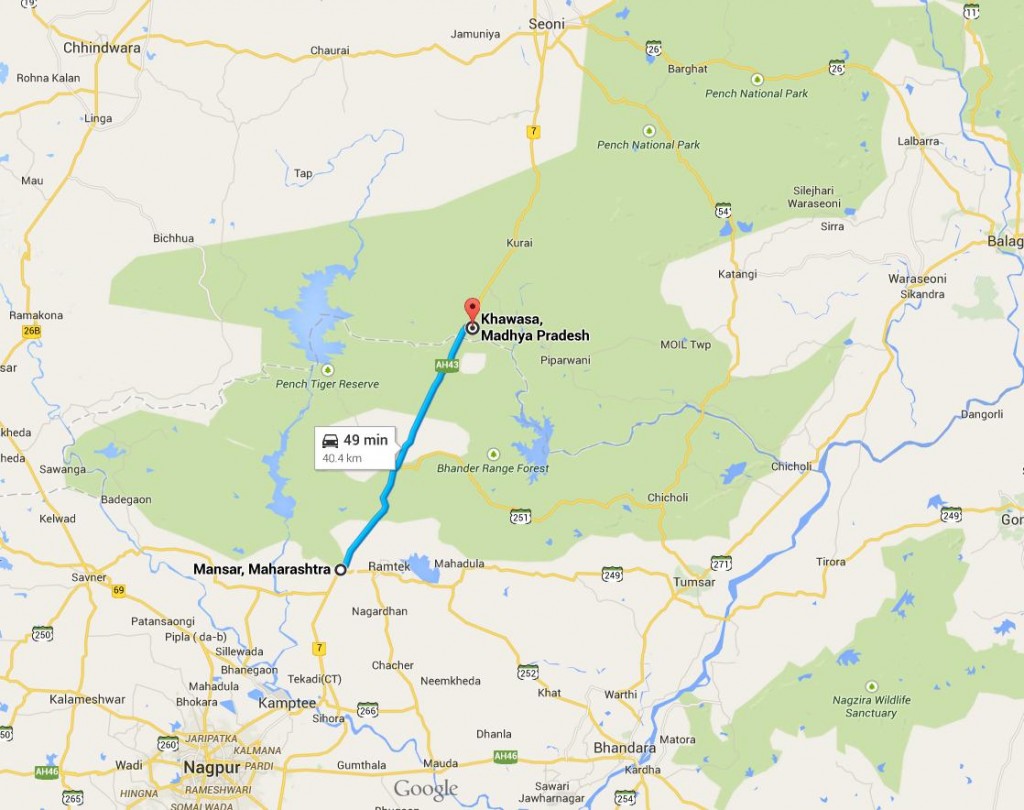
With favourable political masters, the NHAI now doesn’t want to agree to the mitigation plans suggested by WII and wants to reduce its costs without any concern for wildlife. Now, the Government is going ahead with the Mansar-Khawasa stretch which falls in the Maharashtra side and has reportedly agreed to the NHAI mitigation plan instead of the Wildlife Institute of India plan so that an estimated 32 crores is spent instead of 244 crores by not agreeing to construct three overpasses two of which were 1 km long and one was 300m long. The NHAI plan is to only construct three underpasses of 50meters each.
The best mode of saving this tiger habitat is to consider alternate alignment Seoni-Chhindwara-Nagpur. This will increase a distance of about 69km. When good roads are made, this extra distance of 69km can be very easily covered. Industry is interested in good and fast connectivity. 69kms is a small price to pay for saving our tiger landscape. This area has got a very good potential for revival and dispersal of tigers to other sanctuaries. If this landscape is fragmented due to such high-speed four-lane roads, it will act as a body blow for the tiger.
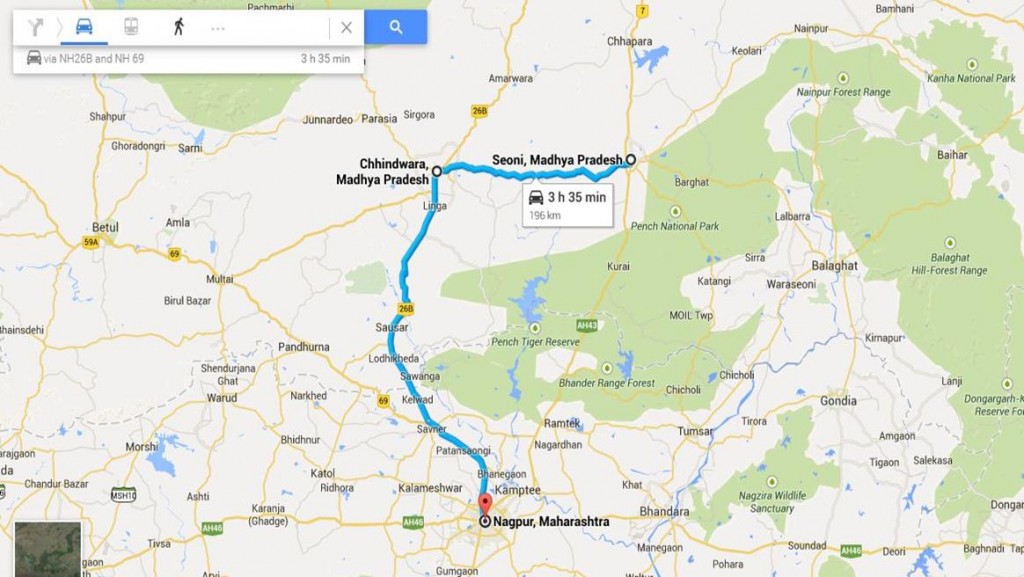
Infrastructure development cannot be at the cost of sacrificing our wilderness areas. These pristine forests give rise to many of our streams and rivers. The trees in our forests also give up moisture which leads to rainfall. Our forests also work as our lungs as they fix the atmospheric carbon dioxide through their chlorophyll and give up oxygen.
And interestingly our forests cannot survive alone without its wildlife. A research paper published in Royal Society of London’s journal Proceedings B in Nov 2014 titled Loss of animal seed dispersal increases extinction risk in a tropical tree species due to pervasive negative density dependence across life stages (Caughlin T. T. et al) concludes that reduction of large herbivores have a cascading effect on the tree species. Habitat fragmentation due to roads not only has impact on the tigers, but also on other herbivores. The herbivores will be more cautious when suddenly their path is blocked by high speed vehicles and only small 50m wide underpasses are created. The herbivores would feel anxious and threatened to use such narrow passages and hence there will be a severe fragmentation of their population leading to inbreeding.
Herpeto-fauna find it very difficult to cross wide roads and many of them get killed while crossing the roads. Smaller carnivores also get killed, as creating three or four underpasses several kilometers apart is not going to help. A study by wildlife biologist R. Arumugam in the Chinar and Aliyar road in theAnamali Tiger Reserve (http://www.indiawilds.com/diary/road-kills-in-chinnar-road-and-aliyar/) showed shocking number of road kills. Though our authorities only talk about the impact on tiger, herbivores as well as lesser carnivores, herpeto-fauna and other insects each play a role in the complex web of inter-relationships to balance our ecosystem and hence need to be preserved in its entirety.
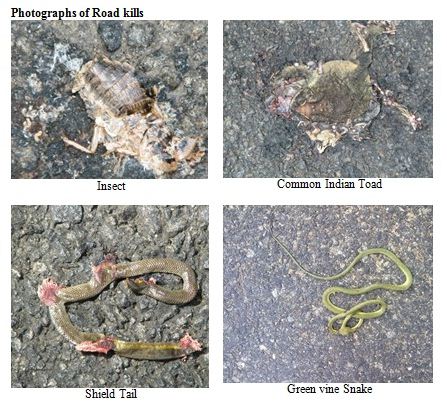
Preserving our wildlife and wilderness areas need will power. Unfortunately, that appears to be a very scarce commodity and is not often displayed by our politicians. The last such display of will power was by Mrs. Indira Gandhi when she banned tiger hunting despite tremendous opposition from the hunting lobby. At that time India didn’t have much of foreign exchange reserves, however, she chose to stop the tiger hunting despite the hunting lobby citing loss of precious foreign exchange. Later Mrs. Indira Gandhi had agreed to start Project Tiger, there by saving the tiger from extinction, atleast till today. Unfortunately, hardly any other PM has shown the same will power in saving Wild India. The previous Prime Minister had the alibi of coalition compulsions. The present BJP Government has absolute majority in the Lok Sabha and hence the current PM doesn’t even have that alibi. Will he show some mettle to save Wild India?
Book Review
The Lions of India by Divyabhanusinh
The book The Lions of India by Divyabhanusinh is a thoughtful compilation of twenty-two articles from the late 1800s till 2008 by many authors. Check this link: http://www.indiawilds.com/diary/the-lions-of-india/

Conservation News:
NGT roadblock to Tree felling for linear projects
The Central Governments blatant push to trash the Forest Conservation Act and allow tree felling for linear projects like roads, canals, gas pipelines etc after in-principle approval has hit a roadblock in form of NGT (National Green Tribunal). The NGT has ordered that non-forest activities be stopped unless a final order has been passed by the State Government.
The NGT issued the direction that such orders be put in the public domain as per the Forest Conservation Act. It also given its verdict that such orders issued by the State Government are appealable.
No non-forest activity in the Forest Area that is covered under Section 2 of the Forest Conservation Act, 1980, will be permitted and carried on in any manner whatsoever, unless an order has been passed by the competent authority of that State government and put in the public domain by putting it on its website and complying with the other requirements in accordance with law, said a Bench headed by NGT chairperson Justice Swatanter Kumar.
As the law has already been stated by the Tribunal, that it is only an order passed under Section 2 of the Forest Conservation Act, 1980, that is appealable under Section 16 of the NGT Act, we direct that appeals will lie against such orders to avoid difficulty to any litigant/ aggrieved person from approaching the Tribunal in accordance with law, it said.
The Bench led by Justice Swatanter Kumar was hearing a petition filed by wildlife biologist Milind Pariwakam, who had challenged the validity of two communications dated August 8, 2014, and January 15, 2015, by the Centre. These two communications had virtually done away with the forest clearance for felling of trees for linear projects like highways, allowing felling and commencement of work right after in-principle clearance.
The National Green Tribunal has said: The legal position undisputed before us is that permitting use of the forest area for non-forest activity can only be permitted under Section 2 of the Forest Conservation Act, 1980, by the State Government in whose jurisdiction the forest falls. It is also undisputed before us that MoEF has intended to provide guidelines for expeditious granting of consent to the linear projects which are amongst others of national importance and necessary for the development of the country.
The Union Government has been trying its best to bend, circumvent, modify and even do away rules that are seen as hindrance by the industry, irrespective of their impact on our bio-diversity. The Minister for MoEF& CC, Shri Prakash Javadekar said the details were yet to be finalised by his ministry on acceptance of the TSR Subramanian Committee recommendation for enactment of a new umbrella law ‘Environment Laws (Management) Act. He said that every recommendation of the TSR Subramanian Committee may not be accepted by the Government. For details of the Subramanian Committee report and its possible impact, one can check here: http://www.indiawilds.com/diary/indiawilds-newsletter-vol-6-issue-xii/
Climate Change: Warm winter in Arctic:
There have been horror stories of sudden snow storms and car accidents with many cars crashing onto each other in the highways in United States due to the cold winter. However, farther to its north, in the Arctic where the winter should have been more severe, it is a different story. During winter there is formation of heavy layers of sea ice in the Arctic Ocean which takes time to melt during the summer. However, this year the sea ice formation in the Arctic ocean is the smallest as per the satellite records of NASA.

According to the analysis done by NSIDC (National Snow and Ice Data Centre) at University of Colorado, which is supported by NASA there have been several major variations this year. The peak of the winter ice cover was reached on 25th of February which is roughly 15 days earlier than the average date of March 12th based on data from 1981 to 2010. The enormity of this incident sinks in when we hear that, only once in 1996 the peak winter ice cover was attained before March 12th and that was only one day before March 12th as opposed to 15 days this year.
This year the peak winter ice cover was 14.54 million square kilometers. The previous lowest peak ice cover was in 2011 and this years peak winter ice cover was a massive 1.1 million square kilometers smaller.
Our earths climate is a result of a complex play of various factors, natural and man-made. With the massive increase in green house gasses due to industrial activities, huge reduction of tree cover which reduces carbon sequestration, the ambient temperature has been steadily increasing. The massive reduction in the winter ice cover in the arctic is a major sign that not everything is well with our mother earth. Though politicians world wide may be oblivious of this fact and keep on wrangling with each other as to who needs to spend more to combat climate change and to protect their narrow interests, climate change has become a reality.
The first to sink into oblivion would be the majestic polar bear. They need the winter ice to move from one place to other in search of food. Without ice cover, they would be stranded without food. Though the Polar Bear being a charismatic species like the tiger and we immediately think about it’s fate when the polar ice caps are lower, it is not the only species at risk. The Ivory Gull (Pagophila eburnea), an endangered species according to IUCN Red List, is also impacted by the sea ice. According to an article titled Annual Movement Patterns of Endangered Ivory Gulls: The Importance of Sea Ice by Spencer NC et al published in PloS ONE on December 31, 2014, not only the timing of formation and recession of the sea ice but also the extent of the sea ice plays a large role in the distribution and migratory timing of Ivory Gull. So one or two warm winters like that of 2015, can cause severe stress on the polar bear population, along with other denizens of the arctic.
With the ice cover reducing, it also impacts the various jet streams and the climate around the globe. After all even though we may categorize each other as black, white, brown and yellow, the survival of all of us is at stake. I hope this incident is given due importance by the United States of America and the other developed countries and the relax a bit from their rigid stance. The BASIC block of countries (Brazil, South Africa, India, China) who are leading the negotiations for the developing countries should also realise that the aping the high carbon life-style of the developed countries shouldn’t be our goal. I hope these complex negotiations end soon, else we will continue to miss the 2020 and 2050 targets and these negotiations may lose their meaning. Pragmatism and statesmanship is the need of the hour.
Quarries & Environmental Clearance:
In a shocking verdict, a division bench of the Kerala High Court ruled that no environmental clearance is required for existing quarries less than 5 hectares. The Hon’ble Kerala High Court said that only new quarries located in kerala require environmental clearance from MoEF. In case where quarrying/mining lease which were existing on the date of issuance of notification dated 14/9/2006 or on the date of issue of the order dated 18/5/2012 by the Government of India, Ministry of Environment and Forests with regard to area less than 5 hectares, no environmental clearance with regard to extraction of minor mineral is required.
In the Deepak Kumar vs Union of India case, the Supreme Court’s interim order in 2012 had asked for environmental clearance for quarrying operations including mining of minor minerals.
The division bench of the Kerala High Court has also said that without a mining plan in place the quarrying operations cannot continue.
These seemingly innocuous small quarries have pockmarked our ecologically fragile areas and no environmental impact assessments is done to consider joint impact of several such quarries in a place. It is time to be stringent with our mining activities.
IndiaWilds App for Android Mobile
In India most of the internet penetration is happening through mobile phones. And the existing users who have access to desktops and laptops are becoming much more mobile then they used to be a few years ago. So to raise awareness and reach out to more people we need to adapt ourselves and make IndiaWilds easily accessed through a mobile phone using android OS.
Today, I am pleased to announce that we have created a mobile phone app so that people can access IndiaWilds anytime, anywhere without being tied to a computer. No need to type. One can access at the click of a button.
We have developed this app through Business Compass LLC a company based in Randolph, New Jersey, United States so that we create a good app.
Awareness is the first step before a person can become a champion of wildlife. I hope this will help us in reaching out to more people to raise awareness and make a real impact on the conservation landscape. If you have an android device then please download the app from this link:
https://play.google.com/store/apps/details?id=com.businesscompassllc.indiawilds
Equipment Discussions
ARRI launches 4k ALEXA SXT cameras
ARRI launches ALEXA SXT (Super Xtended Technology) cameras with ProRes 4k recording.
With its new ALEXA SXT cameras, ARRI has brought in in-camera recording of ProRes 4K UHD (3840 x 2160 pixels) and ProRes 4K Cine (4096 x 2637 pixels). According to ARRI, ALEXA SXT cameras keep the acclaimed 3.4K ALEV III sensor of previous ALEXAs and add the state-of-the-art electronics of ARRI’s groundbreaking ALEXA 65 camera. These high-performance electronics combine the latest generation of FPGA processors with a lightning-fast internal backplane and form the basis of a completely overhauled image processing chain, advanced pixel correction and optional noise reduction. This results in a further improvement in overall image quality. Like their XT predecessors, ALEXA SXT cameras retain the unique and popular Open Gate, 4:3 and 16:9 sensor modes, which can be recorded in ARRIRAW or ProRes.

The creation of new, powerful and unique looks has been made possible by utilizing the advanced color management engine originally developed for the ARRI AMIRA camera. Taking advantage of the extremely wide native color gamut of the ALEXA sensor, this new engine allows unprecedented control, which in the end means greater creative freedom for the filmmaker. A new type of look file, the ALF-2 (ARRI Look File 2), contains an ASC CDL (Color Decision List) as well as a 3D LUT (Look-Up Table). The new color management engine can easily match the look of current ALEXA cameras, but also provides the basis for radically different looks. In addition, previewing of looks on set is improved, including the option to use the wide color gamut of Rec 2020 gamma, while dailies creation is made more efficient and final grading made faster. ALF-2 files and the tools that create them are compatible between ALEXA SXT, ALEXA Mini and AMIRA.
To further streamline on-set workflows ALEXA SXT cameras include three fully independent HD-SDI outputs. This allows, for instance, a Log C image to be used to show the director a pristine image with live grading, a clean Rec 709 image to be fed to video village, and a Rec 709 image with status information overlays to be displayed on the camera’s on-board monitor.
The first ALEXA SXT cameras are planned for release around mid-2015; the full range will comprise ALEXA SXT EV, SXT Plus and SXT Studio models, replacing current ALEXA XT cameras (though the ALEXA Classic EV model will remain in the line-up). ALEXA XT cameras (except ALEXA XT M cameras) shipped between 1st Jan. 2015 and the first shipment of SXT cameras will be eligible for a full SXT upgrade, free of charge.
Concurrent with the ALEXA SXT release ARRI will offer an SXR (Super Xtended Recording) Module upgrade to owners of existing ALEXA XT, XT Plus and XT Studio cameras. The SXR Module upgrade delivers all the features of the SXT cameras, although it might not offer all the future upgrade potential.
The launch of ALEXA SXT is a significant move, as ARRI had steadfastly remained away from the resolution game which RED had brought in. Even though, RED had launched 6K cameras, the good dynamic range, colours, ProRes files among other features had ensured that even with 2K, Alexa was the most popular camera. Last year, as a precursor to this, Arri had launched the Arri Amira with UHD 4K by upscaling in-camera. With Arri moving to 4K, soon 4K acquisition is going to be the standard.
ARRI announces the new ALEXA Mini
ARRI has announced the new ALEXA Mini camera, which is compact, lightweight and has the same fantastic image quality as the ALEXA. Earlier, cameras like C500, C300, RED etc were used with ALEXA in situations like cramped car interiors or for drones where the bigger and heavier ALEXA could not be used. Use of the ALEXA Mini will help in streamlining the workflow and hence should find greater acceptance in sets.

According to ARRI, to maintain ARRI’s famously rugged build quality in a small and lightweight camera, a number of unique design solutions have been incorporated. These include highly integrated and environmentally sealed electronics, a lightweight carbon housing and a solid titanium PL mount that connects directly with the new internal sensor mount to ensure a super-stable flange focal distance, even when using large lenses. Nimble in use and hardy on set, the ALEXA Mini is easy to transport in backpacks or as carry-on luggage.

The ALEXA Mini can be operated in a number of ways: by wireless remote control, as a normal camera with the ARRI MVF-1 multi viewfinder attached, or with an on-board monitor and controlled via the user button interface on the camera body. Light enough to be comfortably held at arm’s length in a hand rig, its compact size and extremely quiet operation also make it ideal for tight shooting conditions. The symmetrical design permits filming in any orientation, including upside-down and in portrait mode, while multiple accessory points enable highly creative mounting solutions. In addition, the ALEXA Mini’s interchangeable lens mount can be replaced with any of those designed for the ARRI AMIRA, allowing the use of B4 video and EF mount stills lenses.
Equipped with a 4:3 sensor, automatic de-squeeze mode for anamorphic productions and frame rates of 0.75-200 fps, the ALEXA Mini records ProRes or uncompressed ARRIRAW either in-camera to CFast 2.0 cards or to a specially-designed external Codex recorder that can record image streams from up to four ALEXA Minis simultaneously — a compelling option for multi-camera setups such as 360 plate shots. Images from the ALEXA Mini will perfectly match those from all other ALEXA cameras, making the final grade easier and quicker.
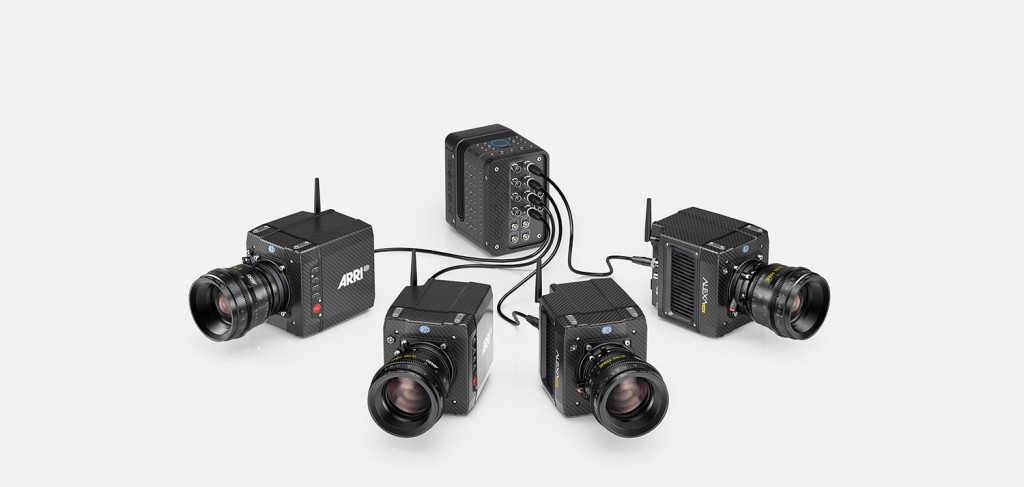
Integrated functionality is at the heart of the ALEXA Mini’s efficient and self-contained design. A built-in lens motor controller allows new active lens motors to be connected directly to the titanium PL mount, while ARRI Lens Data System (LDS) technology provides frame-accurate metadata that can save time and money both on-set and in post. Wi-Fi connectivity means that iOS or Android devices can be used to remotely control camera functions such as the motorized internal ND filters, which permit rapid responses to changing light conditions without adding bulk to the camera configuration.
The body design is optimized for use with new-generation brushless gimbals, multicopters and other specialized rigs. It is compact enough in the lens direction to allow the use of standard PL mount lenses even on lightweight and space-constrained rigs, such as gyro-stabilized aerial systems. The camera’s superb low-light performance makes it perfect for underwater work; dedicated underwater housings are currently being developed by leading manufacturers.
Like the ARRI AMIRA, the ALEXA Mini can record 4K UHD ProRes images, facilitating real-time 4K UHD output and simple pipelines for high-resolution deliverables. More importantly, the Mini and all other ARRI cameras with the ALEV III sensor offer unrivalled overall image quality by focusing not just on spatial resolution, but also on other parameters such as colorimetry, skin tones and High Dynamic Range (HDR). This is equally true whether the chosen output is HD, 2K, 4K UHD or one of the native resolution outputs like uncompressed ARRIRAW 2.8K or ProRes 3.2K, ensuring that images captured with the ALEXA Mini are future-proof, whatever new industry standards emerge.
The ARRI ALEXA Mini is scheduled to begin shipping in May 2015, with orders being taken from March.
Vitec Group acquires Paralinx, seller of wireless video systems
Sound Devices Launches 688 sound recorder
http://www.indiawilds.com/forums/showthread.php?16411-Sound-Devices-Launches-688-sound-recorder
Go Pro Hero 4 Impressions
http://www.indiawilds.com/diary/go-pro-hero-4-impressions/
Natural History
COUNTRY NOTEBOOK: M. Krishnan: ‘A Tongue a cubit long’ By Saktipada Panigrahi
http://www.indiawilds.com/forums/showthread.php?8852-Country-notebook-m-krishnan&p=74085#post74085
Wildlife Photography
Irrawaddy Dolphins in Sunderbans by Mrudul Godbole
http://www.indiawilds.com/forums/showthread.php?16279-Irravady-Dolphins-Sunderbans
Sunderbans Baby Crocodile by Saktipada Panigraphi
Plumbeous Water Redstart by Catherene Christian
Northern Pintail by Samrat Sarkar
http://www.indiawilds.com/forums/showthread.php?16245-Northern-Pintail_Manglajadi
Waterfowls at Nawabganj by Nishith Kumar
http://www.indiawilds.com/forums/showthread.php?16331-Waterfowls-at-Nawabganj-Coot
Dhikala tiger family by Debasis Bose
http://www.indiawilds.com/forums/showthread.php?16296-Close-Encounter-with-Dhikala-Tiger-Family
Leopard at TATR by Subhash Shrivastava
Blackbuck Leaping by Rajbir Oberoi
http://www.indiawilds.com/forums/showthread.php?16321-Blackbuck-Teaching
LRK diary by Vipin Sharma
http://www.indiawilds.com/forums/showthread.php?16272-LRK-Diary-Feb-15
Glass Shrimp by Abhishek Jamalabad
http://www.indiawilds.com/forums/showthread.php?16248-Glass-Shrimp
The horned leaf hopper by Prajwal Ullal
http://www.indiawilds.com/forums/showthread.php?16255-The-horned-leaf-hopper
Some Gold by Roopak Gangadharan
http://www.indiawilds.com/forums/showthread.php?16306-Some-Gold
Infrared Photography: Water monitor by Sabyasachi Patra
http://www.indiawilds.com/forums/showthread.php?16168-Infrared-Photography-Water-monitor
I look forward to your inputs and support in preserving the last tracts of wilderness and wildlife left in our beautiful country. For other interesting articles and images check –http://www.indi
To post in the IndiaWilds forums, you can register free of cost using your Full Name as user id at
http://www.indiawilds.com/forums/register.php
If you are already a member of IndiaWilds and have forgotten your user id and/or password you can mail to
administrator@indiawilds.com
If you want to contribute original articles, or for any image enquiries please send a mail to
administrator@indiawilds.com
Regards,
Sabyasachi Patra
Profile:http://www.indiawilds.com/about.htm
Contact:http://www.indiawilds.com/contact_us.php
Facebook:http://www.facebook.com/pages/IndiaWilds/132629240481
Diary:http://www.indiawilds.com/diary/
Equipment reviews:http://www.indiawilds.com/diary/category/equipment/
Forums:http://www.indiawilds.com/forums/index.php
IndiaWilds Channel:http://www.youtube.com/indiawilds
Please post your views and feedback in the comments below.
- GoPro Hero 12 Black - 6 September,2023
- Leopards: The Last Stand - 2 July,2023
- Drifting in the Waters of Sundarbans - 26 March,2023




